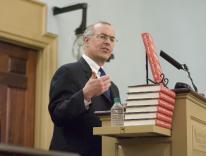
One of the most damaging effects of the current deficit hysteria is that it distracts our attention from the more serious problems our elected officials should be trying to solve. A recent New York Times column by David Brooks, titled “Why Hagel Was Picked,” is a good example of this deficit fixation, which has become common not only on the right but among self-described centrists.
Instead of focusing on the important foreign-policy challenges America faces and whether Senator Hagel is qualified to face them as Secretary of Defense, Brooks explains Hagel’s nomination as the natural consequence of the federal government’s unwillingness to rein in expensive entitlement programs. Brooks argues that the defense budget is being “squeezed by the Medicare vise” and that America will cease to be a world power if it has to provide decent medical care and social protection to the elderly and the poor. “Oswald Spengler didn’t get much right,” Brook writes, “but he was certainly correct when he told European leaders that they could either be global military powers or pay for their welfare states, but they couldn’t do both.”
The first problem with Brooks’s analysis is the assumption that Medicare and Medicaid are themselves the cause of our future fiscal problems. While Brooks is right that the rise in Medicare and Medicaid costs is unsustainable, the reason these costs are rising so fast has nothing to do with bureaucratic waste or profligacy. These federal programs are getting too expensive only because health care in general is getting too expensive. If health-care costs were to keep rising as fast as they have over the past two decades, spending on health care would eventually take over the entire economy: we would all be working solely to pay for our insurance. Obviously this can’t happen. Sooner or later, we will have to fix our health-care system so that it won’t.
As a percentage of GDP, the United States pays more than twice as much for health care as most other rich countries do, and most of these countries have better health outcomes. Clearly, we still need to reform our health-care system. By itself, “Obamacare” will not be enough. The goal of the Affordable Care Act is to extend health-care insurance to as many people as possible. It does this partly by expanding Medicaid but mostly by arranging for more Americans to get private insurance. But simply adding more policy-holders to the ranks of the privately insured will do nothing to curb the cost of health care. We currently pay too much, and receive too little, because the health-care industry has been taken over by Wall Street, whose major goal, with health insurance as with banking, is maximal short-term profit. Its goal is not to make the health-care system cheaper, more efficient, or more just. The insurance industry, which is merely a branch of Wall Street, is itself one of the main causes of out-of-control health-care costs. A system that is both affordable and effective will be possible only when we tame the insurance industry, either by regulating it much more like a public utility, or, better, by taking it out of the equation and replacing it with a single-payer system. You don’t have to look far for evidence that a reasonable and efficient (if not very profitable) health-care system is well within the means of a country as affluent as ours. Countries less affluent have already achieved it.
Brooks may be right that most Americans are unwilling to pay for America to remain the world’s policeman. I suspect most Americans are quite willing to pay enough for the country to defend itself. Today the U.S. military budget is bigger thant the twelve next largest military budgets combined. We account for 45 percent of the world’s military spending even though we have only 5 percent of its population. We spend almost five times as much as China or Russia. Budgeting is about choosing what we value most, and, pace Brooks, it is surely a good sign if Americans decide to stop fighting wars we don’t need to fight so that our government can afford to take care of the elderly and the poor. As Dwight Eisenhower (a Republican) put it, “Every gun that is made, every warship launched, every rocket fired signifies, in the final sense, a theft from those who hunger and are not fed, those who are cold and are not clothed.”
But the biggest problem with Brooks’s analysis is its premise that the federal government’s out-of-control spending will sooner or later cause it to go bankrupt, turning us into the next Greece. It’s true that the aging of our population will require adjustments in how we spend our money (just as the postwar Baby Boom did). But these adjustments will be quite manageable as long as we make intelligent and evidence-based policy decisions. To see what happens when policy-makers disregard evidence in favor of panicked intuition, one need only look at what’s happening right now in the European Union, where harsh austerity programs designed to reduce debt levels have only succeeded in inhibiting economic growth.
Like most deficit hawks, Brooks is worried by dire long-term debt projections. Yet such projections are not a good basis for policy-making, for two reasons. First, they are notoriously inaccurate. Remember the 2000 forecast of federal government surpluses as far as the eye could see? Long-term forecasts are inaccurate because the future is essentially unknowable. All such forecasts are based on the assumption that the future will be just an extension of present trends.
Economists call this the “ergodic axiom.” But all economic history since the advent of capitalism shows that we live in a nonergodic world. This, by the way, is why most economists didn’t foresee the financial meltdown: housing prices had never plunged before, and this was taken to prove they never would. When social scientists make predictions, they often hedge them with the Latin phrase ceteris paribus—“all other things being equal.” But in the long run all other things are not equal. The variables change. Circumstances that are unforeseen and unforeseeable render our old projections moot, or current trends hit a natural limit that the projections disregard.
To give just one example: Most of the long-term projections for federal debt are based on the assumption that health-care spending will continue rising at the rate or near the rate it has in the past twenty years. Yet, as I mentioned before, this is impossible. Frequently the assumptions underlying the projections are chosen to produce a desired outcome, especially for political documents like Paul Ryan’s budget plan. But even if the smartest, best-informed people produce them without any political agenda, long-term forecasts are not very helpful. If people paid more attention to the performance record of past long-term forecasts, they’d take current ones less seriously, or at least more cautiously.
The second reason policy-makers should not allow themselves to be cowed by long-term debt forecasts is that debt does not constrain the U.S. government the way it constrains a business or a household. This is because the U.S. government—unlike, say, the Greek government, which is chained to the euro—pays its bills in its own money and so can always pay for what it wants. The real constraint is future production: Will the economy produce enough goods and services in the future to satisfy the demands of the American people and their government? What government programs we can afford in the future will depend on both demographics and advances in technology—as well as on noneconomic factors like wars, natural disasters, global warming, irrational politicians, and others things beyond the expertise of an economist.
Most analysts look only at demographics when they consider the long-term future of Social Security and Medicare, and this leads them to erroneous conclusions. We are often told that Social Security is unsustainable because the number of workers per retiree is falling. At first glance, this analysis seems to make sense. In 1960 there were 5.1 workers for every retiree; by 2010 that number had fallen to 2. Worse, it is projected to fall to 1.9 in 2086. This looks ominous indeed. But let’s look at another example. In 1940 there was one farmer for every fourteen people. By 1960 the percentage of the population working in agriculture had been cut by more than half, so that each farmer was feeding thirty-four people—more than twice as many as just two decades before. Today each farmer feeds more than 138 people. Yet that fact does not make us worry about a coming food shortage because we all know that, thanks to advances in technology, the average farmer now produces much more food than farmers did in 1960 or 1940.
And what is true of food production is true of economic productivity more generally. The best way to ensure that Social Security will still be around for future generations is to continue supporting government investment in things that will make the economy more productive— above all, in education and research and development.
The budget hawks’ baleful warnings of “unfunded liabilities” is finally meaningless. If we applied the logic of “unfunded liabilities” to food (surely our most important future liability), we’d find that we have an unfunded liability of $359.3 trillion over the next seventy-five years (assuming a modest 3 percent growth rate). Should we then worry that our children are going to starve, as the budget hawks now worry that our children won’t have Social Security? How are we going to pay for all the food people will need? Should we start saving now so we can pay for food in the future? No, of course not: the food we will eat in the future will be food grown in the future, and we will pay for it with future incomes. In the same way, future economic activity will pay for future retirees.
The major economic problems we now face are high unemployment, income inequality, an economy dominated by Wall Street, and a government under its whip. The fact that many House Republicans now appear to be unwilling to let the federal government carry out its basic responsibilities is also a real problem—a real problem based largely on an imaginary one. The irrational fear of debt will become a self-fulfilling prophesy if it leads to austerity policies that make us collectively poorer and therefore less able to produce the goods and services the country will need in the future. The prophets of austerity are like someone who asks us to starve ourselves now so that there will be enough food left for future generations. In fact, the best way to prepare for the future is to take care of the present.
Please email comments to [email protected] and join the conversation on our Facebook page.
Share
Previous Story
Reasons and Habits of the Heart
Next Story
Encountering Jesus


